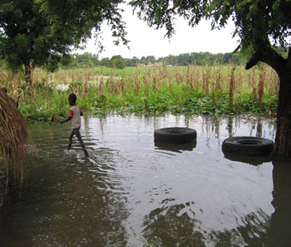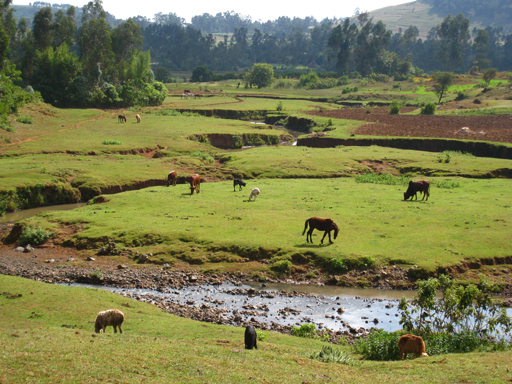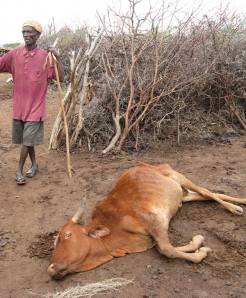11.3 Climate change effects on agriculture, livestock and the Ethiopian economy
Climate change poses huge challenges to the global economy and to social development. Its impacts will disproportionately affect sub-Saharan African countries such as Ethiopia because their economies are highly dependent on climate-sensitive activities such as rain-fed agriculture. In Ethiopia, agriculture contributes about 47% of the country’s Gross Domestic Product (GDP) and more than 70 million people (85% of the Ethiopian population) depend on agriculture directly or indirectly for their livelihoods (Index Mundi, 2014). Therefore, any effect on agriculture will significantly affect the Ethiopian economy.
It is predicted that changes in climate will lead to recurrent droughts and heavy rainfall in different parts of Ethiopia, reducing the amount of land that can be used for agriculture and decreasing crop productivity. For example, the 2006 flood in Gambela region (Figure 11.3) damaged about 1650 hectares of maize and reduced crop productivity by 20% as a result of waterlogging of farmland (Gambela Region Disaster Prevention and Preparedness Agency, 2007). This meant a loss of income for the country and also exacerbated food shortages and malnutrition problems in the region.

The impacts of climate change on the environment could also reduce the national income from the export of agricultural products such as coffee, pulses and flowers. Of particular concern is the possible impact on Ethiopia’s famous Arabica coffee, which is exported all over the world. Coffee plants are very sensitive to climate change and there are concerns that Arabica coffee production could become impossible in Ethiopia by the end of this century if the change continues at the current rate.
Ethiopia is home to Africa’s largest livestock population, and is the world’s tenth-largest producer of livestock and livestock products (MacDonald and Simon, 2011), which make up about 10% of the country’s foreign currency earnings (Pantuliano and Wekesa, 2008). Frequent and extensive droughts in the country have a considerable effect on Ethiopia’s livestock because decreased rainfall shrinks available water resources and reduces the productivity of grassland and rangeland (Figure 11.4).

The main causes of livestock deaths in Ethiopia are shortages of water and food during drought (IFAD, 2009; MacDonald and Simon, 2011). Increased temperatures can affect the behaviour and metabolism (internal body processes) of livestock, such as a reduced intake of food and a decline in productivity (IFAD, 2009; Thornton et al., 2009). Changes in rainfall and warmer temperatures may also increase the geographical distribution and survival ofvectors like flies and mosquitoes that transmit infectious diseases to livestock (IFAD, 2009; Thornton et al., 2009). These impacts on livestock are already being felt in Ethiopia; in the past two decades in Borana zone, southern Ethiopia, there have been losses of livestock associated with drought (Figure 11.5). The number of animals per household declined on average ‘to three oxen from ten; to seven cows from 35; and to six goats, down from 33’ (MacDonald and Simon, 2011).

Like drought, flood has a significant impact on livestock. Animals can be drowned or washed away by flood. For instance, more than 15,600 livestock were lost due to flooding in 2006 in SNNPR (EWD DPPA, 2007). Flood also covers large areas of grazing land with water, making it impossible for the animals to find food.
In addition to affecting agriculture and livestock, floods can cause huge damage to property, livelihoods and infrastructure. This occurred in the 2006 floods in Dire Dawa city, as described in the extract from a government report shown in Box 11.1.
Box 11.1 Impact of the 2006 flood on the Dire Dawa city economy
The flood significantly damaged the livelihoods of 9956 displaced [persons] in Dire Dawa city, washing away their homes and significantly damaging individual assets such as shops, private enterprises and market stalls. Approximately 2685 households were reported to have lost their homes. An additional 1000 homes were also damaged by the flood waters. The damage to livelihood assets had been assessed by the Dire Dawa Investment Bureau, the Dire Dawa Small and Micro Enterprise Agency and the Trade and Industry Office of Dire Dawa. The Investment Bureau found that ten investors lost an estimated 13,162,981 ETB from property damage by the flood. The Dire Dawa Small and Micro Enterprise Agency assessment reported that 882 people incurred losses of 6,697,992 ETB and the Trade and Industry Office also reported the loss of 10,193,302 Birr incurred by 116 traders.
Infrastructure was also severely damaged including roads, the Dechatu River main bridge which cost 2.4 million ETB, Taiwan and Halfkat Irish Crossing and the retaining wall of the Dechatu. In addition, several electric and telephone utility lines and poles were destroyed resulting in a black out in parts of kebeles 05, 06, 07 and 09 for several days. The damage was reported to have incurred the electric and telephone sectors estimated loss of Birr 500,000 and Birr 6,098.36 respectively. On top of these infrastructure damages, all roads found within a 40 [m] radius from the river were completely covered with silt. Its removal and clearance cost about ETB 517,100.
In the surrounding rural areas of Dire Dawa, approximately 257.6 hectares of crops (cereals, vegetables, fruits and cash crops) in 17 kebeles were damaged and six houses were washed away. Soil and water conservation infrastructure in all these kebeles, water schemes in seven kebeles and irrigation schemes in five kebeles, were significantly damaged.
(EWD DPPA, 2007)
11.2 Climate change impacts on the environment
